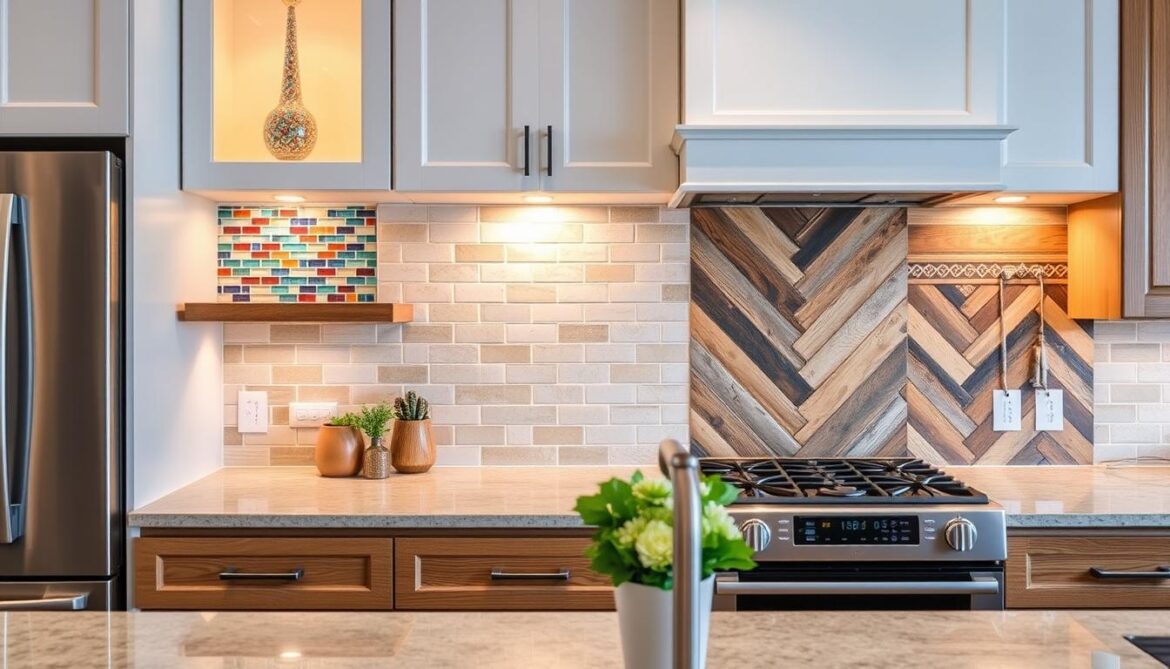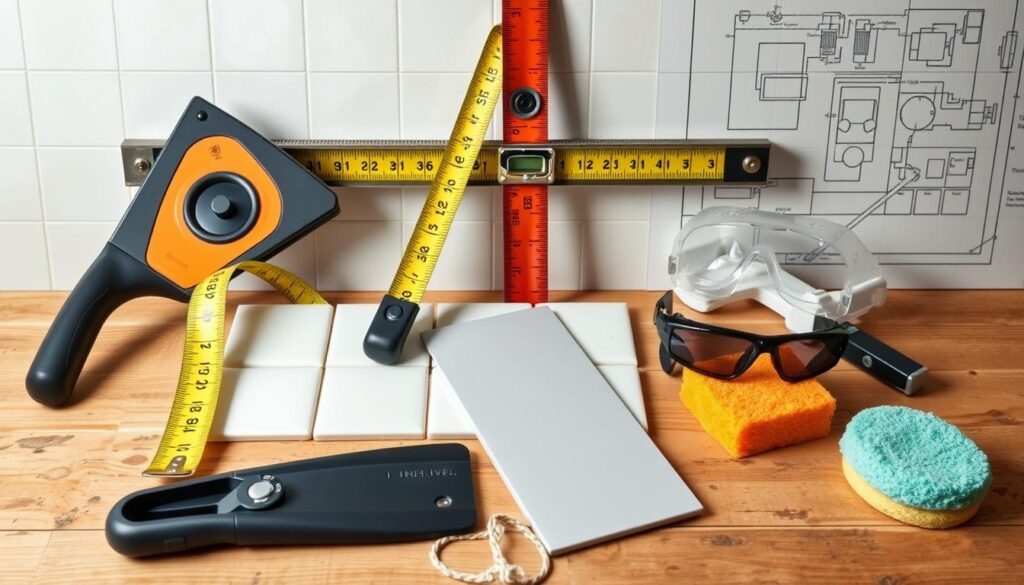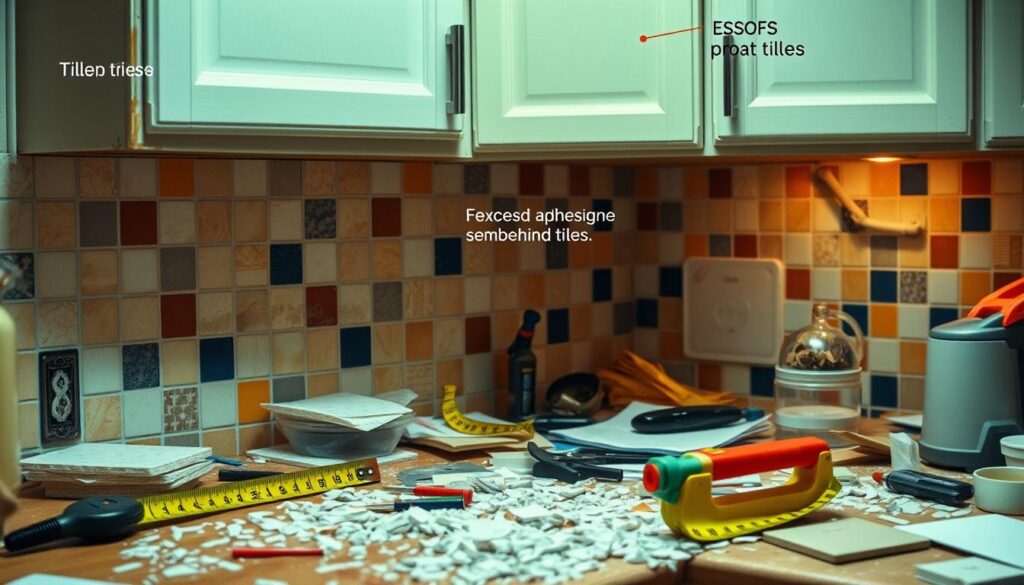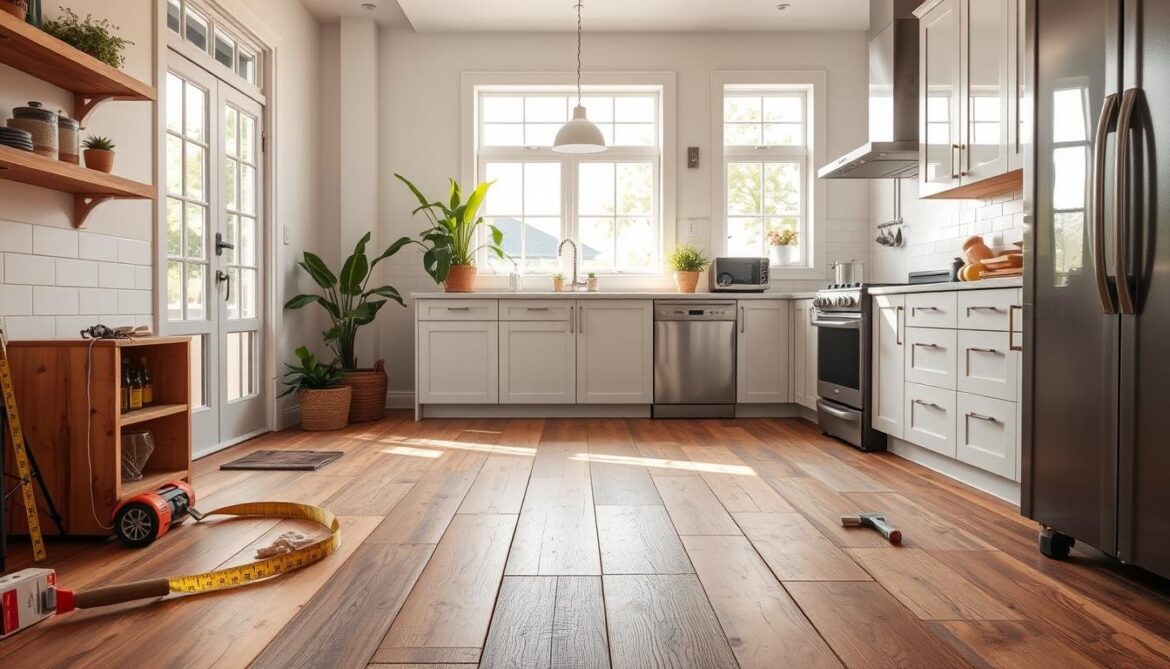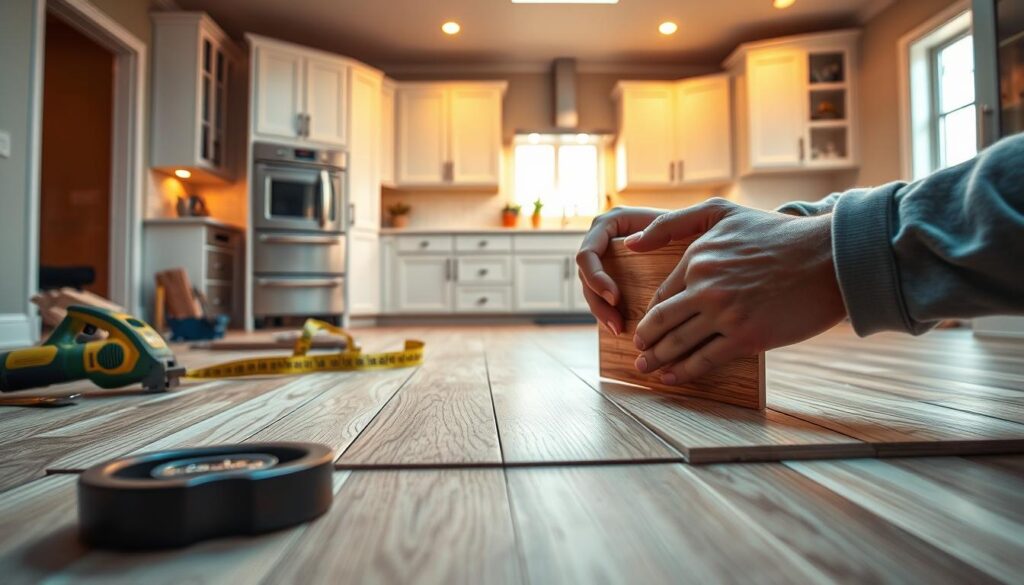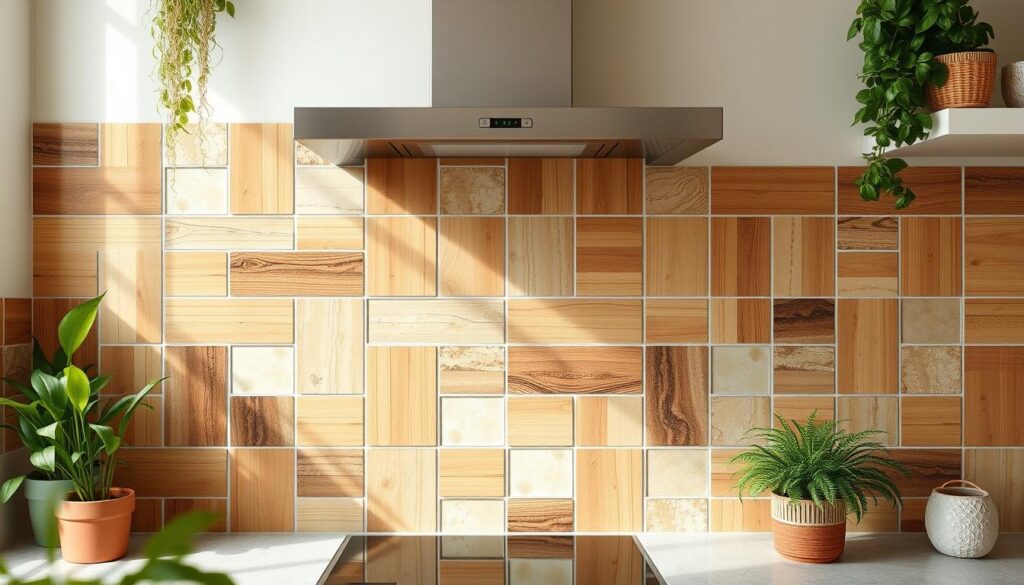Turning your kitchen into a stunning space is easy with a DIY backsplash. Just a bit of creativity and some kitchen tiles can do the trick. It’s a great way to add your personal touch and keep your walls safe from spills.
Creating a DIY backsplash is both fun and rewarding. You can achieve professional results with the right tools and materials. Whether you want a modern look or something vintage, a DIY backsplash can make your kitchen unique.
Doing it yourself not only saves money but also gives you a sense of accomplishment. We’ll show you how to install a DIY kitchen backsplash, from start to finish. You’ll learn how to use DIY backsplash and kitchen tiles.
Why a Kitchen Backsplash is Essential
A kitchen backsplash is key for both looks and function. The right kitchen tiles can make your kitchen welcoming and efficient.
Enhance Aesthetic Appeal
Your backsplash can be a highlight, adding color and texture. It can match or contrast your kitchen’s design. A DIY backsplash lets you show off your style.
Protect Your Walls
Cooking can lead to splashes and spills. A backsplash from durable kitchen tiles shields your walls. It keeps your kitchen clean with little upkeep.
Increase Home Value
A stylish backsplash can raise your home’s value. Buyers like kitchens that are both functional and beautiful. This can make your home more attractive and increase its resale value.
| Benefit | Description |
|---|---|
| Enhances Aesthetics | Adds visual interest and complements kitchen decor. |
| Protects Walls | Prevents damage from spills, stains, and heat. |
| Increases Home Value | Attracts buyers and boosts resale value. |
Types of DIY Kitchen Backsplashes
Choosing the right backsplash can change your kitchen’s look and offer practical benefits. There are many options for your DIY backsplash project.
Tile Options
Traditional tiles like ceramic, porcelain, and natural stone are popular. Ceramic tiles are affordable and come in many colors and patterns. Porcelain tiles are more durable and less porous, great for wet areas.
Natural stone tiles, such as marble or slate, offer a unique and luxurious look. But, they need more care.
Peel-and-Stick Solutions
Peel-and-stick tiles are great for an easy installation. These self-adhesive tiles let you create your own backsplash without a pro. They come in many styles, like faux brick, subway, and mosaic, to fit your kitchen’s look.
Metal and Glass Choices
Metal and glass backsplashes bring a modern and sleek look to kitchens. Stainless steel tiles are durable and easy to clean. They’re a smart choice.
Glass tiles, in clear or colored finishes, reflect light and look stunning. While they need careful installation, their unique look can really improve your kitchen.
Choosing the Right Material for Your Backsplash
Choosing the perfect material for your DIY backsplash can change your kitchen’s look and feel. It’s about picking something that lasts and fits your style.
Durability Considerations
When picking kitchen tiles, think about how they handle heat, moisture, and stains. Porcelain and ceramic tiles are great because they’re tough and easy to clean. They’re perfect for kitchens that are always busy.
Style Compatibility
Your backsplash should match your kitchen’s design. You might want sleek glass tiles for a modern look or subway tiles for a classic vibe. Picking the right material makes your kitchen look better.
Budget-Friendly Options
You don’t have to spend a lot for a beautiful DIY backsplash. Look into affordable options like peel-and-stick tiles or vinyl that look like more expensive materials. These choices are easy to put up and won’t cost a lot, but they’re stylish.
| Material | Pros | Cons |
|---|---|---|
| Porcelain Tiles | Highly durable, moisture-resistant | Can be expensive, requires precise installation |
| Peel-and-Stick Tiles | Affordable, easy to install | Less durable, may not suit all styles |
| Glass Tiles | Modern look, easy to clean | Can show fingerprints, higher cost |
| Vinyl Panels | Budget-friendly, variety of designs | Less durable, may fade over time |
Tools You’ll Need for Installation
Getting ready to install your DIY backsplash means having the right tools. These essentials help make the process smooth and efficient.
Measuring Tools
Getting precise measurements is key for a professional backsplash. You’ll need a good tape measure and a level. This ensures your tiles are straight and evenly spaced.
- Tape Measure: For precise measurements of your workspace.
- Level: To keep your backsplash straight and aligned.
Cutting Tools
Choosing the right cutting tools depends on your backsplash material. Tile cutters are great for ceramic or porcelain tiles. A utility knife is best for peel-and-stick tiles.
- Tile Cutter: Perfect for cutting ceramic or glass tiles.
- Utility Knife: Essential for trimming peel-and-stick tiles to fit.
Adhesive and Grout
Choosing the right adhesive and grout is vital for a lasting installation. For traditional tiles, use tile adhesive and grout. For peel-and-stick tiles, a strong double-sided tape or specific adhesive is best.
- Tile Adhesive: Provides a strong bond for ceramic and stone tiles.
- Grout: Fills the gaps between tiles for a finished look.
- Double-Sided Tape: Ideal for securing peel-and-stick tiles without mess.
| Tool Type | Purpose | Example Brands |
|---|---|---|
| Measuring Tools | Ensuring accurate measurements and level installation | Stanley Tape Measure, Johnson Level |
| Cutting Tools | Trimming tiles to fit specific areas | QEP Tile Cutter, Olfa Utility Knife |
| Adhesive and Grout | Securing tiles and filling gaps | MSI Thinset Mortar, Laticrete Grout, 3M Double-Sided Tape |
Preparing Your Wall for Installation
Before starting your DIY backsplash, make sure your wall is ready. A clean surface helps your kitchen tiles stick well and last longer.
Cleaning the Surface
Begin by cleaning your kitchen walls well. Use a mild detergent and warm water to remove grease, dirt, and residue. For tough stains, mix vinegar and water. Let the wall dry completely for better tile adhesion.
Measuring and Marking
Getting your measurements right is key for a straight backsplash. Measure the area for your tiles. Use a level and pencil to mark lines for your tiles. This ensures your tiles are aligned properly, giving your backsplash a polished look.
Removing Old Backsplash
If you’re replacing an old backsplash, remove the tiles carefully. Use a putty knife or scraper to avoid damaging the wall. For tiles stuck with adhesive, a heat gun might help. Be careful not to harm the wall, which could be drywall or plaster.
| Preparation Task | Tools Needed | Tips |
|---|---|---|
| Cleaning the Surface | Mild detergent, sponge, vinegar | Ensure the wall is completely dry before proceeding. |
| Measuring and Marking | Measuring tape, level, pencil | Double-check measurements for accuracy. |
| Removing Old Backsplash | Putty knife, scraper, heat gun (optional) | Work slowly to avoid damaging the wall. |
Step-by-Step Guide to Installing a Backsplash
Installing a DIY backsplash can change your kitchen easily. Follow these steps for a professional look.
Dry Fitting the Panels
Start by placing your tiles or panels on the countertop without glue. This helps you check alignment and trim tiles if needed.
Applying Adhesive Properly
For regular tiles, spread high-quality adhesive on the wall with a notched trowel. For peel-and-stick tiles, just remove the backing and press firmly, ensuring no air bubbles.
Cutting Tiles as Needed
Measure around outlets, windows, or other spots carefully. Use a tile cutter or sharp knife to trim tiles for a perfect fit.
| Step | Description | Tools Needed |
|---|---|---|
| 1 | Dry fit panels | Tape measure, level |
| 2 | Apply adhesive | Notched trowel, adhesive or peel-and-stick tiles |
| 3 | Cut tiles as needed | Tile cutter, utility knife |
| 4 | Install tiles | Spacers, level |
Grouting and Finishing Touches
As you near the end of your DIY backsplash, focus on the final details. Grouting is key, filling gaps and adding color and texture. It makes your kitchen tiles look professional.
Choosing the right grout is important. Look for a color and type that matches your DIY backsplash. You can pick from many grout colors, from classic white to bold and vibrant ones. Also, pick a grout type that fits your tile material, like cement-based or epoxy-based.
Applying Grout Effectively
To apply grout well, first prepare it as the manufacturer says. Then, use a grout float to spread it evenly between your tiles. Make sure to fill all gaps completely. Use a damp cloth to wipe away excess grout from your tiles, being careful not to remove too much from the gaps.
Cleaning Excess Grout
Cleaning excess grout is key for a professional finish. Use a gentle cleaning solution and a soft cloth to remove any grout haze from your tiles. Avoid harsh chemicals or abrasive materials that can harm your DIY backsplash.
By following these steps and taking your time, you can achieve a beautiful and professional-looking DIY backsplash. It will enhance your kitchen’s overall look.
Common Mistakes to Avoid
Installing a DIY backsplash can change your kitchen. But, you must avoid some common mistakes for success. Here are the ones to watch out for:
Skipping Proper Measurements
Getting the right measurements is key. Without them, your peel-and-stick tiles might not fit right. This can make your backsplash look uneven and waste materials. Always measure your space carefully before you start.
Using Low-Quality Materials
Choosing cheap materials might save money at first. But, they often don’t last long and can peel or fade. Spending more on high-quality peel-and-stick tiles means your backsplash will look good and last for years.
Neglecting Safety Measures
Safety is very important. When using adhesives or grouts, wear protective gear and make sure the area is well-ventilated. This helps avoid accidents and keeps you safe while working.
Maintaining Your DIY Backsplash
Keeping your DIY backsplash in top shape ensures it remains a stunning feature in your kitchen. Regular upkeep will help maintain both its beauty and functionality.
Regular Cleaning Tips
To maintain your kitchen tiles, clean them weekly with a mild soap solution. Use a soft cloth or sponge to avoid scratches. For natural stone tiles, opt for pH-neutral cleaners to preserve their finish.
Addressing Chips and Cracks
Inspect your backsplash periodically for any chips or cracks. Small issues can be repaired using a tile repair kit or matching grout. Prompt repairs prevent water damage and keep your backsplash looking flawless.
Preventing Stains
Apply a sealant to your DIY backsplash to protect against stains. Choose a sealant suitable for your tile type, whether it’s ceramic, glass, or stone. Reapply the sealant annually to ensure continued protection.
Creative Ideas for Backsplash Designs
Designing your DIY kitchen backsplash opens up a world of possibilities. You can pick from many patterns and colors to show off your style. Try using peel-and-stick tiles for a geometric or subway tile look. Mixing different colors and textures adds depth and interest.
A DIY backsplash lets you be creative and think differently. You can use recycled items like bottle caps or broken china for a unique design. Adding personal touches, like family heirlooms or custom tiles, makes it even more special.
Patterns and Colors
Some popular patterns for DIY backsplashes include:
- Herringbone
- Chevron
- Hexagon
For colors, you have many options. You can go for bold and bright or choose something more neutral. Pick a color that matches your kitchen or try something new for a bold look.
Using Upcycled Materials
Using upcycled materials adds a special touch to your backsplash. You can use items like:
- Bottle caps
- Broken china
- Old CDs
These materials can be arranged in many ways to create a unique design. Mixing them with traditional tiles makes your design eco-friendly and one-of-a-kind.
Final Thoughts on Your DIY Project
Congratulations on finishing your DIY kitchen backsplash project! You should be very proud of your work and the new look of your kitchen. The DIY backsplash makes your kitchen look better and protects your walls. It might even make your home more valuable.
Now, take a moment to enjoy your hard work. Your kitchen looks fresh and new. Share your project on social media or in a home improvement forum. You might inspire others to try their own DIY backsplash.
If you want more ideas or help for future projects, check out books, websites, and online forums. With your new skills, you can make many changes to your home.
FAQ
What are the benefits of a DIY kitchen backsplash?
A DIY kitchen backsplash can make your kitchen look better. It also protects your walls from spills and stains. Plus, it can even increase your home’s value. It’s a simple project that can change your kitchen without costing a lot.
What types of DIY backsplash options are available?
You have many DIY backsplash choices. You can pick from traditional tile, like ceramic or stone, or go for peel-and-stick options. Metal or glass backsplashes are also popular. Each has its own benefits and things to consider.
How do I choose the right backsplash material for my kitchen?
When picking a backsplash, think about how durable it is and if it fits your style. Also, consider if it’s affordable. Make sure it can handle your kitchen’s needs and matches your decor.
What tools do I need for a DIY backsplash installation?
For a DIY backsplash, you’ll need tools like measuring tapes and levels. You’ll also need tile cutters and the right adhesives and grouts. Having these tools will make the job easier.
How do I prepare my kitchen wall for a backsplash installation?
To prepare your wall, clean it well and measure and mark the area. If there’s an old backsplash, remove it. These steps help ensure a good fit and strong adhesion.
Can you provide a step-by-step guide for installing a DIY backsplash?
Yes! The process starts with dry-fitting the panels or tiles. Then, apply adhesive and cut tiles as needed. We’ll guide you through each step for a professional look.
What’s the best way to finish the backsplash installation?
Finishing includes grouting and cleaning up excess grout. Choose the right grout color and type. Apply and clean it well for a smooth, professional finish.
What common mistakes should I avoid when installing a DIY backsplash?
Avoid mistakes like bad measurements and using low-quality materials. Also, don’t forget safety. Paying attention to detail and following best practices will help you get great results.
How do I maintain my newly installed DIY backsplash?
To keep your backsplash looking good, clean it regularly. Fix any chips or cracks and prevent stains. Proper care will keep your backsplash looking great for years.
Can I get creative with my DIY backsplash design?
Yes! You can try different patterns, colors, and even use upcycled materials. Be creative and make your backsplash unique. It’s a chance to show off your style and personality.
